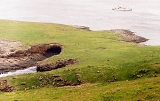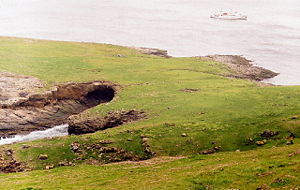
North Rona
Encyclopedia

Scotland
Scotland is a country that is part of the United Kingdom. Occupying the northern third of the island of Great Britain, it shares a border with England to the south and is bounded by the North Sea to the east, the Atlantic Ocean to the north and west, and the North Channel and Irish Sea to the...
island in the North Atlantic. Rona is often referred to as North Rona in order to distinguish it from South Rona
South Rona
Rona , sometimes called South Rona to distinguish it from North Rona, is a small island in the Scottish Inner Hebrides, north of Raasay and northeast of Skye. It has a total area of .-Geography and geology:...
(another small island, in the Inner Hebrides
Inner Hebrides
The Inner Hebrides is an archipelago off the west coast of Scotland, to the south east of the Outer Hebrides. Together these two island chains form the Hebrides, which enjoy a mild oceanic climate. There are 36 inhabited islands and a further 43 uninhabited Inner Hebrides with an area greater than...
). It has an area of 109 hectares (269.3 acre) and a maximum height of 108 metres (354.3 ft)
The island lies 71 kilometres (44.1 mi) north north east of Butt of Lewis
Butt of Lewis
The Butt of Lewis is the most northerly point of the Isle of Lewis in the Outer Hebrides. The headland, which lies in the North Atlantic, is frequently battered by heavy swells and storms.-Lighthouse:...
and 18 kilometres (11.2 mi) east of Sula Sgeir
Sula Sgeir
Sula Sgeir is a small, uninhabited Scottish island in the North Atlantic, west of North Rona...
. More isolated than St Kilda
St Kilda, Scotland
St Kilda is an isolated archipelago west-northwest of North Uist in the North Atlantic Ocean. It contains the westernmost islands of the Outer Hebrides of Scotland. The largest island is Hirta, whose sea cliffs are the highest in the United Kingdom and three other islands , were also used for...
, it is the remotest island in the British Isles
British Isles
The British Isles are a group of islands off the northwest coast of continental Europe that include the islands of Great Britain and Ireland and over six thousand smaller isles. There are two sovereign states located on the islands: the United Kingdom of Great Britain and Northern Ireland and...
to have ever been inhabited on a long-term basis. It is also the closest neighbour to the Faroe Islands
Faroe Islands
The Faroe Islands are an island group situated between the Norwegian Sea and the North Atlantic Ocean, approximately halfway between Scotland and Iceland. The Faroe Islands are a self-governing territory within the Kingdom of Denmark, along with Denmark proper and Greenland...
. Due to the island's remote location and small area, it is omitted from many maps of the United Kingdom.
History

Black Rat
The black rat is a common long-tailed rodent of the genus Rattus in the subfamily Murinae . The species originated in tropical Asia and spread through the Near East in Roman times before reaching Europe by the 1st century and spreading with Europeans across the world.-Taxonomy:The black rat was...
Rattus rattus, which reached the island after a shipwreck. The rats raided the food stocks of barley meal and it is possible the inhabitants starved to death, although plague
Bubonic plague
Plague is a deadly infectious disease that is caused by the enterobacteria Yersinia pestis, named after the French-Swiss bacteriologist Alexandre Yersin. Primarily carried by rodents and spread to humans via fleas, the disease is notorious throughout history, due to the unrivaled scale of death...
may have been a contributory factor. This occurred in a year in which it is reported that no further ships reached the isolated island to supply or trade. The rats themselves eventually starved to death, the huge swells the island experiences preventing their hunting along the rocky shores.
It was resettled, but again depopulated by around 1695 in some sort of boating tragedy, after which it remained home to a succession of shepherds and their families, until 1844 when it was deserted. Sir James Matheson, who bought Lewis in 1844, offered the island to the Government for use as a penal settlement. The offer was refused.
Although farmers from Lewis
Lewis
Lewis is the northern part of Lewis and Harris, the largest island of the Western Isles or Outer Hebrides of Scotland. The total area of Lewis is ....
have continued to graze sheep on Rona ever since, the island has remained uninhabited, apart from one brief and tragic episode in 1884–85. In June 1884, two men from Lewis, Malcolm MacDonald and Murdo Mackay, having reportedly had a dispute with the minister of their local church, went to stay on Rona to look after the sheep. In August, boatmen who had called at the island reported that the men were well and in good spirits, and had refused offers to take them back to Lewis. In April 1885, the next people to visit Rona made a grim discovery: the bodies of the two men from Lewis, who, a post-mortem subsequently showed, had fallen ill and died during the winter.
During World War I
World War I
World War I , which was predominantly called the World War or the Great War from its occurrence until 1939, and the First World War or World War I thereafter, was a major war centred in Europe that began on 28 July 1914 and lasted until 11 November 1918...
, the commander of German U-boat U-90
Unterseeboot 90 (1917)
SM U-90 was a Type Mittel U U-boat of the German Imperial Navy during World War I.The commander, Walter Remy, was noted for making regular stops at the very remote UK island of North Rona for provisions, including fresh mutton....
, Walter Remy, stopped his submarine at North Rona during each of his wartime patrols, weather permitting, and sent crewmen onto the island to shoot sheep to obtain mutton for on-board consumption.
The island was occupied temporarily in 1938–39 by author and conservationist Frank Fraser Darling
Frank Fraser Darling
Sir Frank Fraser Darling was an English ecologist, ornithologist, farmer, conservationist and author, who is strongly associated with the highlands and islands of Scotland.-Early life:...
with his wife Bobbie and their son Alasdair, while they studied the Grey Seal
Grey Seal
The grey seal is found on both shores of the North Atlantic Ocean. It is a large seal of the family Phocidae or "true seals". It is the only species classified in the genus Halichoerus...
s and the breeding seabird
Seabird
Seabirds are birds that have adapted to life within the marine environment. While seabirds vary greatly in lifestyle, behaviour and physiology, they often exhibit striking convergent evolution, as the same environmental problems and feeding niches have resulted in similar adaptations...
s.
The island still boasts the Celt
Celtic Christianity
Celtic Christianity or Insular Christianity refers broadly to certain features of Christianity that were common, or held to be common, across the Celtic-speaking world during the Early Middle Ages...
ic ruins of St Ronan's Chapel. It is owned by Scottish Natural Heritage
Scottish Natural Heritage
Scottish Natural Heritage is a Scottish public body. It is responsible for Scotland's natural heritage, especially its natural, genetic and scenic diversity. It advises the Scottish Government and acts as a government agent in the delivery of conservation designations, i.e...
, and managed as a nature reserve
Nature reserve
A nature reserve is a protected area of importance for wildlife, flora, fauna or features of geological or other special interest, which is reserved and managed for conservation and to provide special opportunities for study or research...
, for its important grey seal
Grey Seal
The grey seal is found on both shores of the North Atlantic Ocean. It is a large seal of the family Phocidae or "true seals". It is the only species classified in the genus Halichoerus...
and seabird colonies. These include the European Storm-petrel
European Storm-petrel
The European Storm Petrel or Storm Petrel is a small bird of the storm-petrel family, Hydrobatidae, part of the seabird order Procellariiformes. It is the only member of the genus Hydrobates.-Description:...
and the larger Leach's Storm-petrel
Leach's Storm-petrel
The Leach's Storm Petrel or Leach's Petrel is a small seabird of the tubenose family. It is named after the British zoologist William Elford Leach....
, for which North Rona is an important breeding locality. Rona and Sula Sgeir
Sula Sgeir
Sula Sgeir is a small, uninhabited Scottish island in the North Atlantic, west of North Rona...
form the most remote and least-visited National Nature Reserve in Britain.
In Island at the edge of the world, the poet Kathleen Jamie
Kathleen Jamie
Kathleen Jamie FRSL is a Scottish poet, raised in Currie, Edinburgh. She gained an M.A. in Philosophy from the University of Edinburgh....
describes a recent visit to the island.
The island hosts an automatic light beacon, remotely monitored by the Northern Lighthouse Board
Northern Lighthouse Board
The Northern Lighthouse Board is the General Lighthouse Authority for Scotland and the Isle of Man. It is a non-departmental public body responsible for marine navigation aids around coastal areas.-History:...
.
See also
Further reading
- Island Going by Robert Atkinson (Collins, 1949)
- A Naturalist on Rona: essays of a biologist in isolation by Frank Fraser Darling (Clarendon Press: Oxford, 1939)
- Island Years by Frank Fraser Darling (G. Bell & Sons, 1940)
- Rona, the Distant Island by Michael Robson (Acair, 1991)

